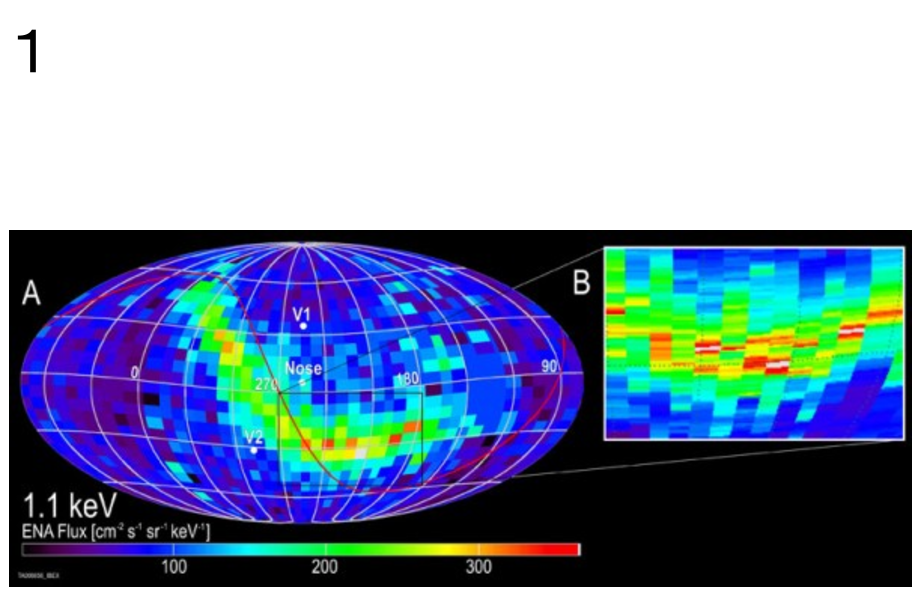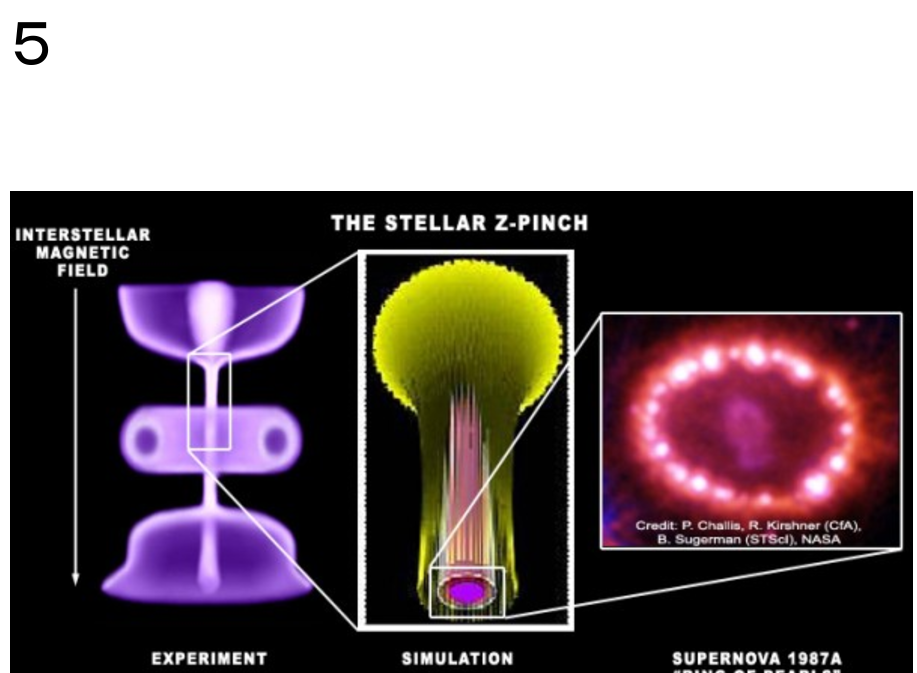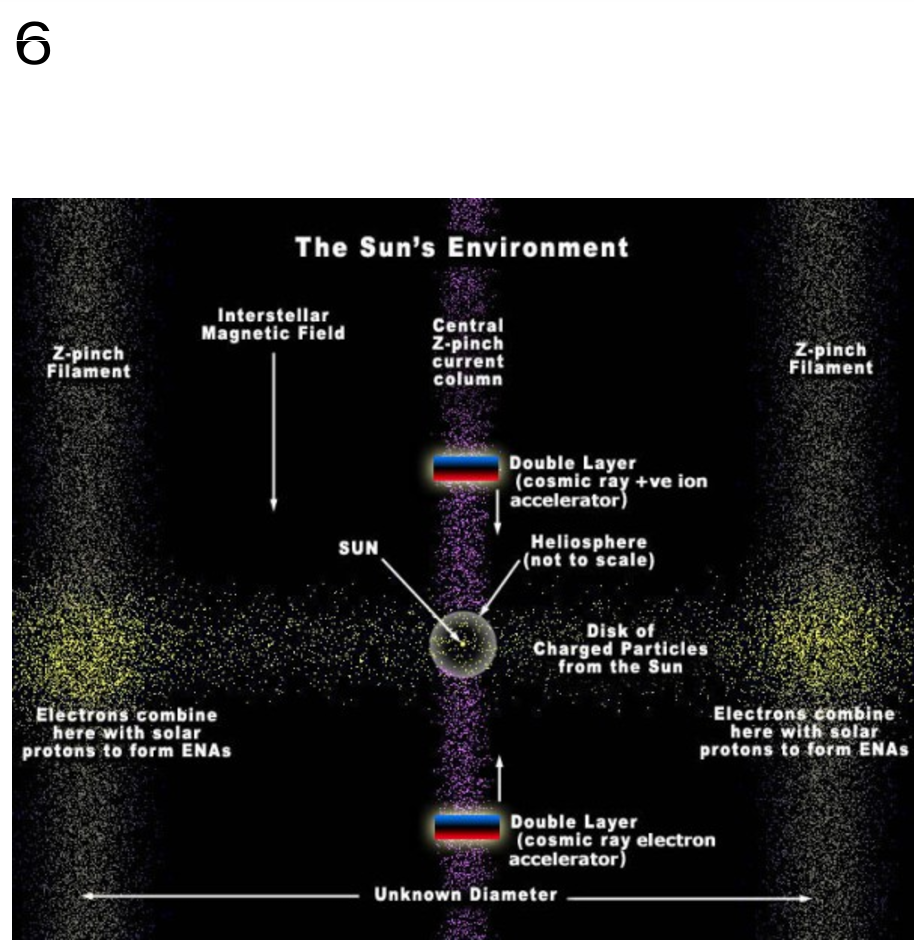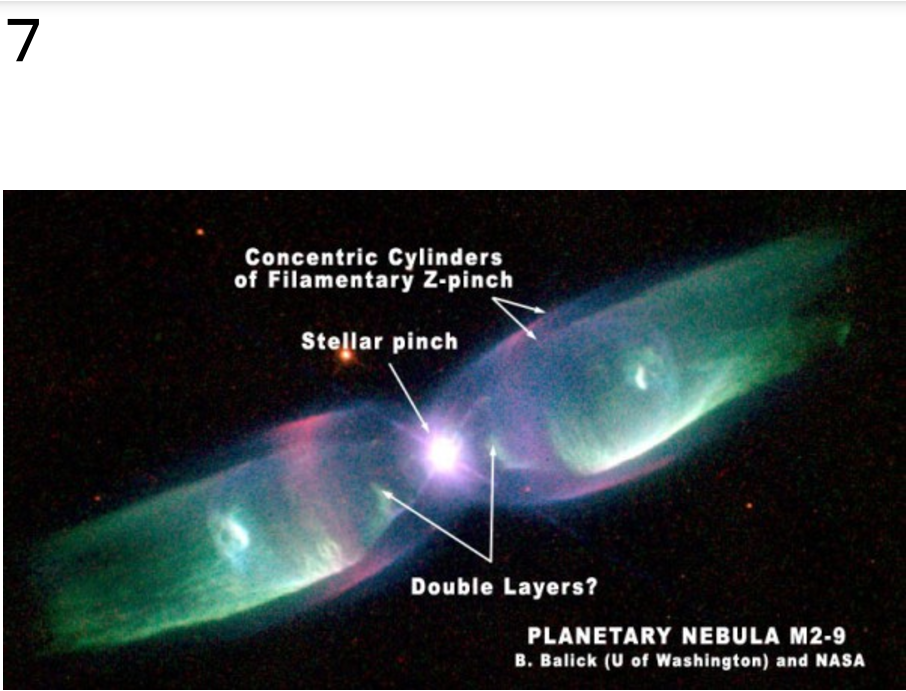Electric Sun Verified 認証済みのエレクトリック・サン
by Wal Thornhill | October 20, 2009 10:16 am
“Is it likely that any astonishing new developments are lying in wait for us? Is it possible that the cosmology of 500 years hence will extend as far beyond our present beliefs as our cosmology goes beyond that of Newton?”
「何か驚くべき新たな展開が私たちを待っているのではないでしょうか?
私たちの宇宙論がニュートンの宇宙論を超えるのと同じように、500 年後の宇宙論が私たちの現在の信念をはるかに超えて広がる可能性はあるでしょうか?」
—Fred Hoyle, The Nature of the Universe
—フレッド・ホイル、『宇宙の性質』
――――――――
NASA’s IBEX (Interstellar Boundary Explorer) spacecraft has made the first all-sky maps of the boundary between the Sun’s environment (the heliosphere), and interstellar space.
NASA の IBEX (恒星間境界探査機) 探査機は、太陽の環境 (太陽圏) と恒星間空間との境界を示す初の全天地図を作成しました。
The results, reported as a bright, winding ribbon of unknown origin which bisects the maps, have taken researchers by surprise. However, the discovery fits the electric model of stars perfectly.
その結果は、地図を二分する起源不明の明るく曲がりくねったリボンとして報告され、研究者らを驚かせた。 しかし、この発見は恒星の電気的モデルに完全に適合します。
1

[1] [Credit: SwRI]
Voyagers 1 and 2 (V1 and V2 above) reached the boundary of the Sun’s influence in 2005 and 2007, respectively, taking measurements as they left the solar system.
ボイジャー 1 号と 2 (上記の V1 と V2) は、それぞれ 2005 年と 2007 年に太陽の影響の境界に到達し、太陽系を離れるときに測定を行いました。
Before IBEX, there was only data from these two points at the edge of the solar system.
IBEX が登場する前は、太陽系の端にあるこれら 2 つの地点からのデータしかありませんでした。
While exciting and valuable, the data they provided about this region raised more questions* than they resolved.
この地域に関して彼らが提供したデータは刺激的で貴重なものでしたが、解決するよりも多くの疑問*を引き起こしました。
IBEX has filled in the entire interaction region, revealing surprising details completely unpredicted by any theories.
IBEX は相互作用領域全体の中に埋め尽くされており、理論ではまったく予測できなかった驚くべき詳細を明らかにしました。
This shows some of the fine detail of the ribbon in the blow-up section.
これは、展開セクションのリボンの細部の一部を示しています。
[*See Voyager 1 at the Edge – of What?[2]]
[* ボイジャー 1 号の最果て – 何の?[2] を参照]
The meter-wide, hexagonal IBEX monitors the edge of the solar system from Earth orbit by “seeing” the heliosphere’s outer boundary in the “light” of energetic neutral hydrogen atoms (ENA’s).
幅メートルの六角形の IBEX は、エネルギーのある中性水素原子 (ENA) の「光」で太陽圏の外側の境界を「見る」ことによって、地球周回軌道から太陽系の端を監視します。
The news releases of October 15 highlighted the difficulties this discovery causes.
10月15日のニュースリリースは、この発見が引き起こす困難を強調しました。
“The thing that’s really shocking is this ribbon,” says IBEX principal investigator David McComas of Southwest Research Institute in San Antonio, Texas.
「本当に衝撃的だったのは、このリボンです」
テキサス州サンアントニオにあるサウスウエスト研究所のIBEX主任研究員デイビッド・マコマス氏はこう語る。
Researchers had expected gusts in the solar wind blowing against the boundary to create 20% or 30% variations in ENA emissions, but the ribbon is 10 times that intense
—a narrow band blazing across the sky like some Milky Way on fire.
研究者らは、境界に向かって吹く太陽風の突風がENA放出量に20%か30%の変動をもたらすと予想していたが、
リボンは、— 燃える天の川のように空を横切る狭い帯で、その10倍の強烈さでした。
Charged particles have apparently become bunched along the ribbon near the boundary, says McComas, but how they got there
マコマス氏によると、荷電粒子は明らかに境界付近のリボンに沿って束になっているが、しかし、彼らはどうやってそこにたどり着いたのか、
“is still a big mystery. Our previous ideas about the outer heliosphere are going to have to be revised.” 「それはまだ大きな謎です。 太陽圏の外側についてのこれまでの考えは修正される必要があるでしょう。」
と言います。
“I’m blown away completely,”
says space physicist Neil Murphy of NASA’s Jet Propulsion Laboratory in Pasadena, California.
“It’s amazing, it’s opened up a new kind of astronomy.”
「私は、完全に衝撃を受けました」
と、カリフォルニア州パサデナにあるNASAジェット推進研究所の宇宙物理学者ニール・マーフィー氏は言う。
「それは、驚くべきことです。新しい種類の天文学が開かれました。」
2
[3] [Credit: S. M. Krimigis et al., The Johns Hopkins University Applied Physics Laboratory.]
Annotated summary of basic findings from the ENA maps of the heliosheath by researchers from the Saturn Cassini mission.
土星カッシーニ計画の研究者によるヘリオシースの ENA マップからの基本的な発見の注釈付きの要約。
――――――――
“The expectations of NASA scientists are not being met because their shock front model is incorrect.
The boundary that Voyager has reached is more complex and structured than a mechanical impact.”
「NASA の科学者らの期待は満たされていません。衝撃波面のモデルが間違っているからです。
ボイジャーが到達した境界は、機械的な衝撃よりも、もっと複雑で構造的なものです。」
—Wal Thornhill, September 2006.
―ウォル・ソーンヒル、2006 年 9 月。
3

[4] [Image credit: Adler Planetarium/Chicago]
The publicized image of the Sun’s interaction with interstellar space is like the shock front of a supersonic aircraft.
太陽と星間空間との相互作用の公表された画像は、超音速航空機の衝撃波面のようなものです。
We are told the “magnetic bubble” of the heliosphere protects us like a cocoon as the Sun and its planets travel through the Milky Way.
太陽とその惑星が天の川を通って移動するとき、太陽圏の「磁気の泡」が繭のように私たちを守ってくれていると言われています。
The concept of Langmuir’s plasma sheath is entirely missing from this picture.
この写真には、ラングミュアのプラズマ シースの概念がまったくありません。
It is electrically inert.
それは、電気的に不活性です。
――――――――
IBEX has discovered that the heliosheath is dominated not by the Sun but by the Galaxy’s magnetic field. Since the galaxy’s magnetic field traces the direction of interstellar electric current flow in space near the Sun, it is a result that conforms to the EU model of galaxies[5] and stars[6].
IBEX は、ヘリオシースが太陽ではなく銀河の磁場によって支配されていることを発見しました。 銀河の磁場は太陽近傍の宇宙空間で恒星間電流の流れの方向をたどるため、EU の銀河モデル [5] や恒星 [6] に準拠した結果となります。
It is necessary to acknowledge that the cometary heliosphere model seems reasonable when some images of stars do have a cometary appearance.
いくつかの恒星の画像が実際に彗星のように見える場合、彗星の太陽圏モデルは合理的であると思われることを認識する必要があります。
――――――――
Examples of cometary stars[7] are provided in the NASA news report:
彗星的な恒星達の例[7]は、NASA ニュースレポートで提供されています:
4

[8] [Credit: SwRI]
This image shows photographs of the heliospheres around other stars (called astrospheres) taken by a variety of telescopes.
この画像は、さまざまな望遠鏡で撮影された、他の恒星達の周囲の太陽圏 (天体圏と呼ばれます) の写真を示しています。
(Note that the title of the original has been changed here from “Astrospheres” because it makes the unsupported assumption that all stars have them in this cometary form).
(原文のタイトルは、すべての恒星達がこの彗星の形をしているという根拠のない仮定をしているため、ここでは「Astrospheres(天体圏)」から変更されていることに注意してください)。
Cometary phenomena are not a simple mechanical effect of an object plowing through a thin gas.
(恒星達の)彗星的現象は、薄いガスの中を物体が通過するという単純な機械的影響ではありません。
Comets are an electrical phenomenon where the comet nucleus is a negative cathode in the Sun’s plasma discharge.
彗星は、彗星の核が太陽のプラズマ放電の負の陰極となる電気的現象です。
Examples of cometary stars are uncommon because stars are normally a positive anode in the galactic discharge.
恒星達は通常、銀河放電の陽極であるため、彗星的恒星の例はまれです。
Characteristically, cathodes tend to jet matter into the plasma to form spectacular comas and tails, as seen above.
特徴として、陰極は物質をプラズマに噴射して、上に見られるように壮観なコマと尾を形成する傾向があります。
Stars may become comets in the process of electrical capture by a more highly charged star.
恒星達は、より高度に帯電した(他の)恒星による電気的な捕獲の過程で彗星(的)になる可能性があります。
It is a mistake to assume a cometary astrosphere model for all stars.
すべての恒星達に対して彗星の天球圏モデルを仮定するのは間違いです。
However, a more fundamental conceptual error is to invoke stellar and galactic “winds” and the notion of tails being “swept downstream.”
しかし、より根本的な概念上の誤りは、恒星や銀河の「風」や尾が「下流に流される」という概念を持ち出すことです。
Astrospheres and comets are plasma discharge phenomena!
天体も彗星もプラズマ放電現象です!
Electrodynamic forces govern them. Discussions about the “external magnetic forces of the galactic wind” dominating the shape of the heliosphere highlights a curious blindspot in astrophysics.
電気力学的な力がそれらを支配します。 太陽圏の形状を支配する「銀河風の外部磁力」に関する議論は、天体物理学の奇妙な盲点を浮き彫りにします。
In 1970 the late Hannes Alfvén counseled against the notion that magnetic fields can exist in space while ignoring their origin in cosmic electric currents and their circuits.
1970年、故ハンネス・アルフベンは、磁場が宇宙電流とその回路に由来することを無視して宇宙に存在し得るという考えに反対しました。
Alfvén predicted an imminent “crisis in cosmology.”
アルヴェーンは差し迫った「宇宙論の危機」を予言しました。
I’m sure he never imagined that scientific revolutions could take a century or more in this era of global communication.
きっと彼は、この世界的なコミュニケーションの時代において、科学革命が 1 世紀以上かかるとは想像もしていなかったに違いありません。
But specialism and specialist jargon is the enemy of communication and the wide-ranging investigation needed to compose the “big picture” we call cosmology.
しかし、専門性や専門用語は、コミュニケーションや、私たちが宇宙論と呼ぶ「全体像」を構成するために必要な広範な調査の敵です。
And no scientist likes to admit their specialty is in crisis.
そして、自分の専門分野が危機に瀕していることを認めい科学者はいません。
For a more detailed perspective on the astrophysical crisis, I recommend my earlier article of April 2007, “The Astrophysical Crisis at Red Square[9].”
天体物理学の危機に関するより詳細な視点については、2007 年 4 月の私の以前の記事「赤の広場における天体物理学の危機[9]」をお勧めします。
There I wrote:
そこで私はこう書きました:
“Alfvén pioneered the stellar circuit concept and it seems his ‘wiring diagram’ is essentially correct but incomplete because it does not show the star’s connection to the larger galactic circuit.
「アルヴェーンは恒星回路の概念の先駆者であり、彼の『配線図』は本質的には正しいようですが、恒星とより大きな銀河回路との接続が示されていないため不完全です。
Alfvén remarked, “The [stellar] current closes at large distances, but we do not know where.”
アルヴェーン氏は、「[恒星]電流は遠く離れたところで閉じるが、どこで閉じるのかは分からない。」と述べた。
Plasma cosmologists have supplied the answer by mapping the currents flowing along the arms of spiral galaxies.
プラズマ宇宙学者は、渦巻銀河の腕に沿って流れる電流をマッピングすることで答えを提供しました。
It is but a small step from there to see that all stars are the focus of Z-pinches within a galactic discharge.
すべての恒星達が銀河の放電内の Z ピンチの焦点であることがわかるまでは、そこからほんの小さな一歩です。
Normally the current flows in ‘dark mode’ so we don’t usually see the spectacular bipolar ‘wiring harnesses’ of hyperactive stars.”
通常、電流は「ダークモード」で流れるので、私たちは通常、多動恒星達の見事な双極性の「ワイヤーハーネス」を見ることはありません。」
――――――――
The diagram appearing in that article is shown below, re-annotated.
その記事に掲載されている図を再注釈して以下に示します。
has so far not found a satisfactory explanation.””]
今のところ満足のいく説明は見つかっていない。””]
5

[10]Meanwhile, in 2005 I explained all three rings of supernova 1987A[11]in terms of a stellar plasma Z-pinch.
一方、2005 年に、私は超新星 1987A[11] の 3 つのリングすべてを恒星プラズマ Z ピンチの観点から説明しました。
Above we see the essential features of a plasma Z-pinch experiment (left);
the details of the concentric Birkeland current filament cylinders (center);
and the ‘witness plate’ resulting from the galactic Birkeland current filaments in that cylinder striking the matter in the disk expelled from the star at the focus of supernova 1987A.
上には、プラズマ Z ピンチ実験の重要な特徴が示されています (左);
同心のバークランド電流フィラメント シリンダーの詳細 (中央);
そして、その円筒内の銀河バークランド電流フィラメントが、超新星 1987A の焦点で恒星から放出された円盤内の物質に衝突することによって生じる「目撃板」です。
The bright beads are like the effect of a ring of searchlights punching through a thin cloud.
明るいビーズは、薄い雲を突き抜けるサーチライトの輪のような効果です。
The tendency for pairing of the bright circular spots and the extremely slow expansion rate of the equatorial ring suggest the Z-pinch model is correct.
明るい円形スポットのペアの傾向と赤道リングの膨張速度が非常に遅いことから、このZ ピンチ・モデルが正しいことが示唆されます。
A normal star will have the same Z-pinch environment as a supernova but at a much lower energy.
通常の恒星は超新星と同じ Z ピンチ環境になりますが、エネルギーははるかに低くなります。
So instead of a brilliant ring of lights in the sky, astronomers detect a ‘bright ribbon’ of ENA’s, caused by modest excitation of matter from the Sun’s stellar “wind” by the local galactic Z-pinch.
そのため、天文学者たちは、空に輝く光の輪の代わりに、局所的な銀河の Z ピンチによる太陽の恒星の「風」からの物質の適度な励起によって引き起こされる ENA の「明るいリボン」を検出しました。
6

[12]This diagram shows a conceptual cross-section along the central axis of the stellar Z-pinch at the Sun’s position.
この図は、太陽の位置における恒星の Z ピンチの中心軸に沿った概念的な断面を示しています。
Whether the double layers exist within or outside the heliosphere is unknown.
二重層が太陽圏の内側に存在するか外側に存在するかは不明です。
The diameter of the encircling cylinder is unknown.
取り囲む円筒の直径は不明です。
That of supernova 1987A is of the order of a light-year, which would make the diameter of the heliosphere more than 600 times smaller!
超新星 1987A の直径は 1 光年のオーダーであり、太陽圏の直径は 600 分の 1 以上小さくなります。
Note that as a rotating charged body the Sun’s magnetic field is not aligned with the interstellar magnetic field and Z-pinch axis.
回転する荷電体として、太陽の磁場は恒星間磁場および Z ピンチ軸と一致していないことに注意してください。
The Sun’s magnetic field only has influence within the tiny heliosphere but it is modulated by galactic currents.
太陽の磁場は小さな太陽圏内でのみ影響を及ぼしますが、銀河流によって調整されます。
Alfvén’s axial “double layers” (DLs) have been included although their distance from the Sun is unknown.
アルヴェーンの軸方向「二重層」(DL)は、太陽からの距離は不明ですが、含まれています。
DLs are produced in current carrying plasma and are the one region where charge separation takes place in plasma and a high voltage is generated across them (see discussion below).
DL達は、電流が流れるプラズマ内で生成され、プラズマ内で電荷分離が発生し、その両端に高電圧が生成される 1 つの領域です (以下の説明を参照)。
The Z-pinch model offers a simple explanation for the “giant ribbon” found wrapped around the heliosphere.
Z ピンチ・モデルは、太陽圏の周りに巻かれているのが発見された「巨大なリボン」を簡単に説明します。
The Z-pinch is naturally aligned with the interstellar magnetic field.
Z ピンチは自然に恒星間磁場と一致します。
Solar “wind” ions are scattered and neutralized by electrons from the Birkeland current filaments to form ENA’s coming from the Z-pinch ring, a giant ring about the solar system and orthogonal to the interstellar magnetic field.
太陽の「風」イオンは、バークランド電流フィラメントからの電子によって散乱および中和され、Zピンチリング(太陽系の周囲にあり恒星間磁場に直交する巨大なリング)から来るENAを形成します。
The Sun’s heliospheric circuit is connected to the galaxy via the central column and the disk of charged particles.
太陽の太陽圏回路は、中心柱と荷電粒子の円盤を介して銀河に接続されています。
The current path is traced by magnetic fields.
電流経路は磁場によって追跡されます。
The “open” helical magnetic fields discovered high above the Sun’s poles by the Ulysses spacecraft are supportive of Alfvén’s stellar circuit model.
ユリシーズ宇宙船によって太陽の極の上空で発見された「開いた」螺旋状磁場は、アルヴェーンの恒星回路モデルを裏付けています。
And the solar “wind” would seem to connect to the broader disk of charged particles about the heliosphere.
そして、太陽の「風」は、太陽圏の周りの荷電粒子のより広い円盤につながっているように見えます。
Given the detail in this model we should expect, as more data comes in, that researchers may find in the ENA “ribbon,” bright spots, filamentary structures, and movement of the bright spots consistent with rotation of Birkeland current filament pairs and their possible coalescence.
このモデルの詳細を考慮すると、より多くのデータが入ってくると予想されるはずです、研究者は、ENAの「リボン」、輝点、フィラメント構造、およびバークランド電流フィラメント対の回転とそれらの合体の可能性と一致する輝点の動きを発見する可能性があります。
The Science journal reports the opinion of one of the researchers that:
サイエンス誌は、ある研究者の意見を次のように報じています:
“sorting out the heliosphere’s true shape will take more time …the geometry’s tough.
「太陽圏の本当の形状を解明するにはさらに時間がかかります…幾何学は難しいです。
The shape is no doubt somewhere between the two extremes of ideal comet and pure bubble, but all agree that researchers will have to understand how the ribbon forms to know the heliosphere’s true shape.”
この形状が理想的な彗星(の形状)と純粋な泡(の形状)の両極端の間のどこかにあることは間違いありませんが、太陽圏の本当の形状を知るためには、リボンがどのように形成されるかを研究者が理解する必要があることに全員が同意しています。」
――――――――
That is true, but scientists will continue to suffer surprises while they have “no doubt” that the galactic wind and the interstellar magnetic field are the dominant forces that shape the heliosphere.
それは事実だが、一方、彼らは銀河風と恒星間磁場が太陽圏を形成する支配的な力であることを「疑いの余地なく」持っています、科学者たちは今後も驚きに悩まされるだろう。
Researchers are keen to see how changes in the solar wind affect the ENA observations as the sun moves toward the maximum of its 11-year cycle.
研究者らは、太陽が11年周期の最大値に向かって移動するにつれて、太陽風の変化がENAの観測にどのような影響を与えるかに注目しています。
Such observations are very important.
このような観察は非常に重要です。
The solar cycle is controlled by its local galactic Z-pinch, so any variation in ENA’s may provide some clues about the origin of the quasi-cyclic variability in the circuit supplying DC electrical power to the Sun or “solar cycle.”
太陽周期は局所的な銀河の Z ピンチによって制御されているため、ENA の変動は、太陽に DC 電力を供給する回路の準周期変動、つまり「太陽周期」の起源に関する手がかりを提供する可能性があります。
The “brightness” of the ENA’s should vary, probably out of phase with the solar cycle.
ENA の「明るさ」は変化するはずで、おそらく太陽周期とは位相がずれています。
In 1984 Alfvén predicted from his circuit model of the Sun there are two double layers, one connected to each pole at some unknown distance from the Sun or heliosphere.
1984 年にアルヴェーンは、太陽の回路モデルから 2 つの二重層が存在し、1 つは太陽または太陽圏から、未知の距離にある各極に接続されていると予測しました。
He wrote:
彼は書きました:
“As neither double layer nor circuit can be derived from magnetofluid models of a plasma, such models are useless for treating energy transfer by means of double layers.
「プラズマの磁性流体モデルからは二重層も回路も導き出すことができないため、そのようなモデルは二重層によるエネルギー伝達を扱うのには役に立ちません。
They must be replaced by particle models and circuit theory… Application to the heliospheric current systems leads to the prediction of two double layers on the sun’s axis which may give radiations detectable from Earth.
それらは粒子モデルと回路理論に置き換えられなければなりません…太陽圏の電流システムに適用すると、太陽の軸上に 2 つの二重層が存在し、地球から検出可能な放射線が得られる可能性があると予測されます。
Double layers in space should be classified as a new type of celestial object.”
宇宙の二重層は新しいタイプの天体として分類されるべきです。」
— H. Alfvén, Double Layers and Circuits in Astrophysics, IEEE Transactions On Plasma Science, Vol. PS-14, No. 6, December 1986.
— H. アルヴェーン、天体物理学における二重層と回路、IEEE Transactions On Plasma Science、Vol. PS-14、第 6 号、1986 年 12 月。
――――――――
There is some other research to be encouraged by this ENAs discovery, which should throw further light on the Sun’s electrical environment.
この ENA の発見によって促進される研究は他にもいくつかあり、それは太陽の電気的環境にさらなる光を当てるはずです。
The axial double layers should be detectable as nearby, fluctuating radio and cosmic ray sources.
軸性二重層は、近くの変動する電波源および宇宙線源として検出可能でなければなりません。
In fact their oscillation may modulate the current flow and be a source of the solar cycle.
実際、それらの振動は電流の流れを調節し、太陽周期の原因となっている可能性があります。
Already there has been a report[13] of an unexplained high-energy cosmic ray “hot spot” roughly in the direction of the inferred “heliotail.”
推定される「ヘリオテール」のほぼその方向に、説明のつかない高エネルギー宇宙線「ホットスポット」があるという報告がすでに報告されています[13]。
The energies of the cosmic rays are in the range possible by acceleration in a galactic double layer (Carlqvist).
宇宙線のエネルギーは、銀河二重層(カールクヴィスト)での加速によって可能な範囲にあります。
Confirmation may soon come from observations of high-energy cosmic-ray electrons.
高エネルギー宇宙線電子の観測によって間もなく確証が得られるかもしれない。
The electrons undergo synchrotron and inverse Compton scattering losses and thus cannot travel very far from their sources, which makes them sensitive probes of nearby galactic sources and propagation.
電子はシンクロトロン散乱および逆コンプトン散乱損失を受けるため、電子源からそれほど遠くまで移動することができず、そのため近くの銀河源および伝播の高感度プローブとなります。
If the diagram above is close to the real situation then we might expect cosmic-ray electrons to arrive from the double layer in the opposite direction in the sky to the nuclear cosmic rays.
上の図が実際の状況に近い場合、宇宙線電子は二重層から空の核(融合)宇宙線とは逆の方向に到達すると予想されるかもしれません。
7

[14]
The EU model is based on a hierarchy of repeated patterns of plasma behavior, from the size of a galaxy down to a few centimeters in the laboratory.
EU(エレクトリック・ユニバース) モデルは、銀河のサイズから実験室の数センチメートルに至るまで、プラズマの挙動の階層的な繰り返しパターンに基づいています。
Therefore it is subject to experimental confirmation, unlike most astrophysical theory today.
したがって、今日のほとんどの天体物理学理論とは異なり、実験による確認の対象となります。
So discoveries from space like this one should trigger experiments in plasma laboratories around the world instead of theorists wasting resources by conjuring up ever more complex and unlikely models based on invalid concepts of space plasma.
したがって、このような宇宙からの発見は、理論家が宇宙プラズマの無効な概念に基づいて、これまで以上に複雑でありそうもないモデルを思いつくことでリソースを無駄にするのではなく、世界中のプラズマ研究所で実験を引き起こす必要があります。
IBEX’s recent results that have taken researchers by surprise have given yet more strength to the EU model, a model that confidently predicts that the shape of the Sun’s galactic plasma environment is the hourglass, Z-pinch shape of planetary nebulae and supernovae, aligned with the local interstellar magnetic field.
研究者らを驚かせたIBEXの最近の結果は、EUモデルにさらなる力を与えた、このモデルは、太陽の銀河プラズマ環境の形状が、局所的な恒星間磁場と一致する、惑星状星雲と超新星の砂時計のZピンチ形状であると自信を持って予測するモデルである。
The beautiful symmetrical patterns that arise in plasma discharges from very simple principles renders all modeling that ignores the electrical nature of matter and the universe worthless.
非常に単純な原理からプラズマ放電に生じる美しい対称パターンは、物質と宇宙の電気的性質を無視したすべてのモデリングを無価値にしてしまいます。
Wal Thornhill
ウォル・ソーンヒル
Endnotes:
1. [Image]: /wp/wp-content/uploads/2012/04/Heliospheric-ribbon.jpg
2. Voyager 1 at the Edge – of What?: http://www.holoscience.com/news.php?article=0yfteeje
3. [Image]: /wp/wp-content/uploads/2009/10/Heliosphere.jpg
4. [Image]: /wp/wp-content/uploads/2009/10/Cometary-Sun.jpg
5. galaxies: http://www.holoscience.com/news.php?article=2m1r5m3b
6. stars: http://www.holoscience.com/news.php?article=x49g6gsf
7. Examples of cometary stars: http://www.nasa.gov/mission_pages/ibex/allsky_visuals.html
8. [Image]: /wp/wp-content/uploads/2009/10/Stellar-comets.jpg
9. The Astrophysical Crisis at Red Square: http://www.holoscience.com/news.php?article=7hjpuqz9
10. [Image]: /wp/wp-content/uploads/2009/10/Stellar-Z-pinch.jpg
11. supernova 1987A: http://www.holoscience.com/news.php?article=re6qxnz1
12. [Image]: /wp/wp-content/uploads/2009/10/Solar-Environment.jpg
13. report: http://physics.aps.org/articles/v1/37
14. [Image]: /wp/wp-content/uploads/2009/10/Planetary-nebula-M2-9.jpg
Source URL: https://www.holoscience.com/wp/electric-sun-verified/
Copyright ©2024 holoscience.com | The ELECTRIC UNIVERSE® unless otherwise noted.